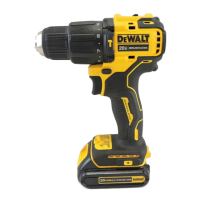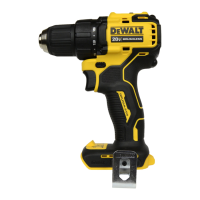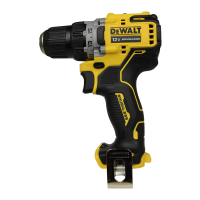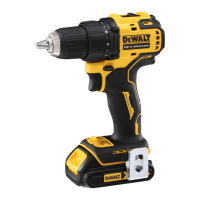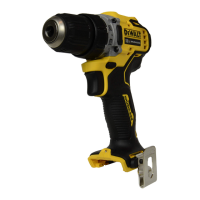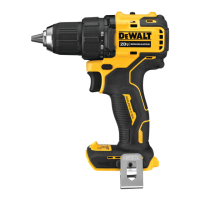ENGLISH
32
Fig. E
11
Keyless Single Sleeve Chuck (Fig. F)
Your tool features a keyless chuck with one rotating sleeve
for one-handed operation of the chuck. To insert a drill bit or
other accessory, follow thesesteps.
1. Lock the trigger in the OFF position as
previouslydescribed.
2. Grasp the black sleeve of the chuck with one hand
and use the other hand to secure the tool. Rotate the
sleeve counterclockwise far enough to accept the
desiredaccessory.
3. Insert the accessory about 3/4" (19 mm) into the chuck
and tighten securely by rotating the chuck sleeve
clockwise with one hand while holding the tool with the
other. Your tool is equipped with an automatic spindle
lock mechanism. This allows you to open and close the
chuck with onehand.
4. To release the accessory, repeat step 2above.
WARNING: Do not attempt to tighten drill bits (or
any other accessory) by gripping the front part of the
chuck and turning the tool on. Damage to the chuck
and personal injury may result. Always lock off trigger
switch when changingacces sories.
5. Be sure to tighten chuck with one hand on the
chuck sleeve and one hand holding the tool for
maximumtightness.
Fig. F
Chuck Removal (Fig. G)
Turn the adjustment collar
4
to the “drill” position and
gear shifter
5
to position 1 (low speed). Tighten the chuck
around the shorter end of a hex key (not supplied) of 1/4"
(6mm) or greater size. Using a wooden mallet or similar
object, strike the longer end in the clockwise direction, as
shown. This will loosen the screw inside thechuck.
Open chuck jaws fully, insert screwdriver (or Torx tool if
required) into front of chuck between jaws to engage
screw head. Remove screw by turning clockwise (left-hand-
thread). Place hex key in chuck and tighten, as shown in
FigureH. Using a wooden mallet or similar object, strike key
sharply in the counterclockwise direction. This will loosen
the chuck so that it can be unscrewed byhand.
Fig. G
Fig. H
4
5
4
5
Chuck Installation (Fig. H)
Screw the chuck on by hand as far as it will go and insert
screw (left-hand thread). Tighten screw securely. Tighten
the chuck around the shorter end of a 1/4" (6mm) or larger
hex key (not supplied) strike the longer end in the clockwise
direction with a wooden mallet, as shown. Tighten the
screw once again by turning in a counterclockwisedirection.
Drill Operation (Fig. A)
WARNING: To reduce the risk of serious personal
injury, turn tool off and disconnect tool from
power source before making any adjustments or
removing/installing attachments or accessories.
An accidental start-up can causeinjury.
WARNING: TO REDUCE THE RISK OF PERSONAL
INJURY, ALWAYS ensure workpiece is anchored or
clamped firmly. If drilling thin material, use a wood
“back-up” block to prevent damage to thematerial.
Turn the collar
4
to the drill bit symbol for drilling. Select
the desired speed/torque range using the gear shifter
5
to
match the speed and torque to the plannedoperation.
1. Use sharp drill bits only. For WOOD, use twist drill bits,
spade bits, or hole saws. For METAL, use high-speed
steel (HSS) twist drill bits or holesaws.
2. Always apply pressure in a straight line with the bit. Use
enough pressure to keep drill biting, but do not push
hard enough to stall the motor or deflect thebit.
3. Hold tool firmly with both hands to control the twisting
action of thedrill.
WARNING: The drill may stall if overloaded causing
a sudden twist. Always expect the stall. Grip the drill
firmly with both hands to control the twisting action
and avoidinjury.
4. IF DRILL STALLS, it is usually because it is being
overloaded or improperly used. RELEASE TRIGGER
